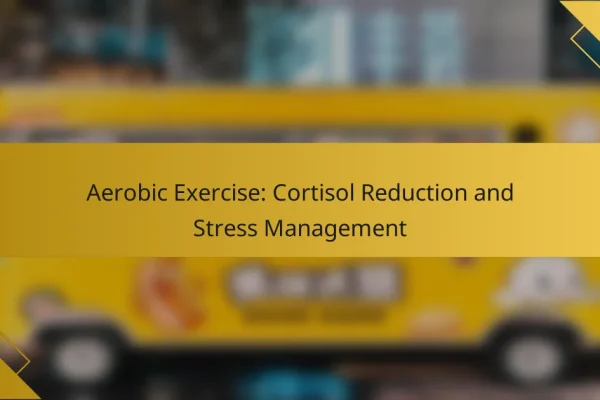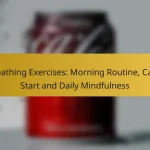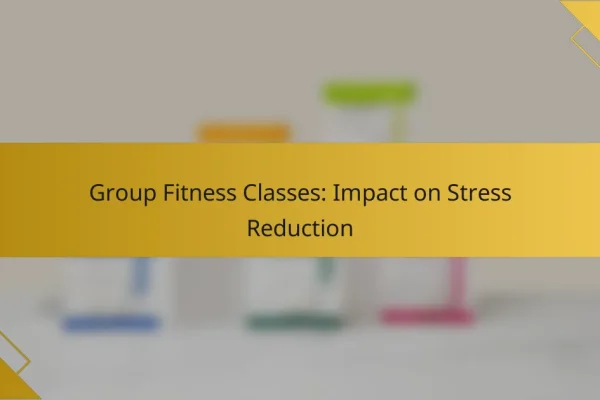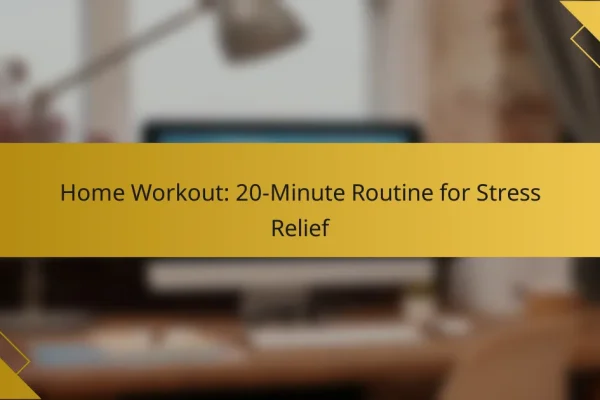How does physical activity relieve stress?
Physical activity relieves stress by triggering biological responses that lower stress hormones and enhance feelings of well-being. Engaging in regular exercise can lead to significant improvements in mental health by promoting relaxation and reducing anxiety levels.
Reduces cortisol levels
Physical activity is effective in lowering cortisol, a hormone associated with stress. When you engage in exercise, your body responds by reducing cortisol production, which can help alleviate feelings of tension and anxiety.
Activities such as jogging, cycling, or even brisk walking can lead to noticeable reductions in cortisol levels. Aim for at least 30 minutes of moderate exercise most days of the week to experience these benefits.
Increases endorphin production
Exercise stimulates the release of endorphins, often referred to as “feel-good” hormones. These chemicals interact with the receptors in your brain to reduce the perception of pain and trigger positive feelings.
Even short bursts of physical activity, such as a quick workout or a short run, can lead to a significant endorphin boost. This natural high can help combat stress and improve your overall mood.
Improves sleep quality
Regular physical activity can enhance sleep quality, which is crucial for stress management. Exercise helps you fall asleep faster and deepens your sleep, allowing your body to recover and rejuvenate.
To maximize sleep benefits, aim to finish exercising at least a few hours before bedtime. Activities like yoga or stretching in the evening can also promote relaxation and prepare your body for restful sleep.
Enhances mood
Engaging in physical activity can significantly enhance your mood by reducing feelings of depression and anxiety. Exercise promotes a sense of accomplishment and can serve as a healthy distraction from daily stressors.
Participating in group activities, such as team sports or fitness classes, can further boost your mood by providing social interaction, which is beneficial for emotional well-being.
Boosts self-esteem
Physical activity can lead to improvements in self-esteem and confidence. As you achieve fitness goals, whether big or small, you may feel a greater sense of control over your life and body.
Setting realistic fitness goals and celebrating your progress can reinforce positive self-image. Regular exercise can also help you develop a more positive body image, contributing to overall mental health and stress reduction.
What types of physical activities are best for stress relief?
Physical activities that effectively relieve stress include yoga, running, swimming, strength training, and dancing. Each of these activities engages the body and mind, promoting relaxation and reducing anxiety through various mechanisms.
Yoga
Yoga combines physical postures, breathing exercises, and meditation, making it a holistic approach to stress relief. Practicing yoga can enhance flexibility, strength, and mental clarity while reducing tension in the body.
To get started, consider joining a local class or following online tutorials. Aim for at least 30 minutes of practice a few times a week to experience significant benefits.
Running
Running is a powerful cardiovascular exercise that releases endorphins, often referred to as “feel-good” hormones. This natural high can significantly improve mood and alleviate stress.
For beginners, start with short distances, gradually increasing your pace and duration. Running outdoors can also provide additional mental benefits from nature exposure.
Swimming
Swimming offers a low-impact workout that can be particularly soothing due to the water’s buoyancy. The rhythmic nature of swimming can help calm the mind while providing a full-body workout.
Try to swim at least twice a week for about 30 minutes. Whether in a pool or open water, the experience can be refreshing and stress-relieving.
Strength training
Strength training involves lifting weights or using resistance to build muscle, which can also help reduce stress. This type of exercise promotes the release of endorphins and can improve self-esteem and body image.
Incorporate strength training into your routine 2-3 times a week, focusing on different muscle groups each session. Start with lighter weights and gradually increase as you gain strength.
Dancing
Dancing is a fun and expressive way to relieve stress while getting a workout. It combines physical movement with music, which can elevate mood and foster social connections.
Join a dance class or simply dance at home to your favorite music. Aim for at least 30 minutes of dancing a few times a week to enjoy the stress-relieving benefits.
How often should you engage in physical activity for stress relief?
To effectively relieve stress, aim for at least 150 minutes of physical activity each week. This can be broken down into manageable sessions, making it easier to incorporate into your routine.
At least 150 minutes per week
Engaging in at least 150 minutes of moderate-intensity aerobic activity weekly is a widely recommended guideline for stress relief. This can include activities like brisk walking, cycling, or swimming. Spreading this time over the week can make it more achievable and less daunting.
Consider breaking this down into 30-minute sessions five times a week. If time is tight, shorter sessions can still be effective, as long as they add up to the total weekly goal.
Daily short sessions
Incorporating short physical activity sessions into your daily routine can be beneficial for stress relief. Even 10 to 15 minutes of exercise can help elevate your mood and reduce anxiety. Activities like stretching, yoga, or a quick walk can fit easily into a busy schedule.
Consistency is key; aim to include some form of physical activity every day. This not only helps manage stress but also builds a habit that can lead to long-term health benefits.
Mixing moderate and vigorous activities
Combining moderate and vigorous physical activities can enhance stress relief. Moderate activities, such as brisk walking, can be alternated with vigorous exercises like running or high-intensity interval training (HIIT) for greater benefits. This variety keeps your routine engaging and can improve overall fitness.
For example, you might walk briskly for 30 minutes on some days and engage in a more intense workout for 20 minutes on others. This mix allows you to adapt your exercise to how you feel each day while still meeting your weekly activity goals.
What are the benefits of group physical activities?
Group physical activities offer numerous benefits, including improved motivation, enhanced social support, and increased accountability. Engaging in exercise with others can lead to a more enjoyable experience and greater commitment to fitness goals.
Increased motivation
Participating in group physical activities can significantly boost motivation levels. When individuals work out together, they often encourage one another, making it easier to push through challenging workouts. The shared experience can create a sense of camaraderie that helps maintain enthusiasm over time.
To maximize motivation, consider joining local fitness classes or community sports teams. These environments foster a sense of belonging and can lead to long-term commitment to physical activity.
Social support
Social support is a crucial aspect of group physical activities, as it provides emotional encouragement and practical assistance. Friends and fellow participants can help each other stay focused on their fitness goals, share tips, and celebrate achievements together.
Building a supportive network can be as simple as inviting friends to join a workout session or participating in group challenges. This connection can make exercising more enjoyable and less isolating.
Enhanced accountability
Group physical activities enhance accountability by creating a commitment to others. When individuals know that their peers are counting on them, they are more likely to show up and participate regularly. This shared responsibility can lead to better adherence to fitness routines.
To strengthen accountability, set specific group goals or challenges. For example, committing to attend a weekly class together or tracking progress as a team can help maintain focus and dedication to the group’s fitness journey.
What role does location play in stress-relieving activities?
Location significantly influences the effectiveness of stress-relieving activities. Access to natural environments, recreational facilities, and community spaces can enhance the benefits of physical activity for stress relief.
Natural environments
Engaging in physical activity in natural settings, such as parks or forests, can reduce stress levels more effectively than urban environments. Nature exposure has been linked to lower cortisol levels and improved mood. Aim for locations with greenery, water bodies, or scenic views to maximize these benefits.
Accessibility of facilities
Having nearby recreational facilities, such as gyms, sports clubs, or community centers, can encourage regular participation in physical activities. Consider the availability of amenities like swimming pools, courts, or fitness classes when choosing a location. Easy access can lead to more consistent engagement, which is crucial for stress management.
Community involvement
Participating in group activities within your community can enhance the stress-relieving effects of physical exercise. Joining local sports teams, fitness groups, or walking clubs fosters social connections, which are vital for emotional well-being. Look for community events or classes that align with your interests to boost motivation and enjoyment.












